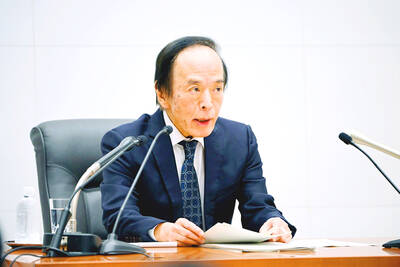Key exports in Singapore, which is already in recession, fell by a worse-than-forecast 15.3 percent last month, government data showed on yesterday.
Singapore is Southeast Asia’s wealthiest economy in terms of per capita GDP but is heavily dependent on trade.
This makes it sensitive to hiccups in developed economies, particularly key export markets such as the US and Europe.
The 15.3 percent year-on-year drop in non-oil domestic exports (NODX) compared with an annual decline of 8.75 percent that had been forecast in a Dow Jones Newswires poll of analysts.
Exports fell for the sixth straight month, hurt by a fall in shipments to the US, the EU and Malaysia, the trade promotion body International Enterprise (IE) Singapore said.
The drop for last month was greater than the 5.7 percent fall in September, and stemmed from lower exports of electronic and non-electronic goods, the trade agency said.
Electronics shipments fell 15 percent, led by consumer electronic goods, which fell 53.3 percent, it said.
Aside from electronics, NODX fell 15.5 percent, with pharmaceuticals down 38.9 percent.
On a month-on-month seasonally adjusted basis, NODX fell by 7.4 percent last month after a 0.9 percent fall in September.
Non-oil domestic exports to all of the top 10 markets except Indonesia contracted last month. Shipments to the EU were off 13.7 percent while those to the US fell 31.2 percent, IE Singapore said.
Total trade declined by 0.2 percent year-on-year to US$51 billion.
NODX reached its highest level last year in October, meaning last month’s numbers were compared against a very high base, DBS Group Research said in a report.
It said electronics was declining at a worsening rate while technology companies were relocating to lower-cost countries.
DBS said: “And given the current global economic conditions, the outlook for this sector in Singapore is exceptionally bleak going forward.”
Singapore last month became the first Asian economy to fall into recession when the Ministry of Trade and Industry released data showing real GDP declined by 6.3 percent in the third quarter after contracting 5.7 percent in the 2nd quarter.
The ministry lowered the full-year growth forecast to around 3 percent, citing a slowdown in the global economy and key domestic sectors. More detailed third-quarter data is to be released on Friday.
Singaporean Prime Minister Lee Hsien Loong (李顯龍) warned on Sunday that the country could experience negative growth next year. He said the recession would probably last a year but beyond that there could be several years of slow growth.

Taiwan’s long-term economic competitiveness will hinge not only on national champions like Taiwan Semiconductor Manufacturing Co. (TSMC, 台積電) but also on the widespread adoption of artificial intelligence (AI) and other emerging technologies, a US-based scholar has said. At a lecture in Taipei on Tuesday, Jeffrey Ding, assistant professor of political science at the George Washington University and author of "Technology and the Rise of Great Powers," argued that historical experience shows that general-purpose technologies (GPTs) — such as electricity, computers and now AI — shape long-term economic advantages through their diffusion across the broader economy. "What really matters is not who pioneers

In a high-security Shenzhen laboratory, Chinese scientists have built what Washington has spent years trying to prevent: a prototype of a machine capable of producing the cutting-edge semiconductor chips that power artificial intelligence (AI), smartphones and weapons central to Western military dominance, Reuters has learned. Completed early this year and undergoing testing, the prototype fills nearly an entire factory floor. It was built by a team of former engineers from Dutch semiconductor giant ASML who reverse-engineered the company’s extreme ultraviolet lithography (EUV) machines, according to two people with knowledge of the project. EUV machines sit at the heart of a technological Cold

TAIWAN VALUE CHAIN: Foxtron is to fully own Luxgen following the transaction and it plans to launch a new electric model, the Foxtron Bria, in Taiwan next year Yulon Motor Co (裕隆汽車) yesterday said that its board of directors approved the disposal of its electric vehicle (EV) unit, Luxgen Motor Co (納智捷汽車), to Foxtron Vehicle Technologies Co (鴻華先進) for NT$787.6 million (US$24.98 million). Foxtron, a half-half joint venture between Yulon affiliate Hua-Chuang Automobile Information Technical Center Co (華創車電) and Hon Hai Precision Industry Co (鴻海精密), expects to wrap up the deal in the first quarter of next year. Foxtron would fully own Luxgen following the transaction, including five car distributing companies, outlets and all employees. The deal is subject to the approval of the Fair Trade Commission, Foxtron said. “Foxtron will be

INFLATION CONSIDERATION: The BOJ governor said that it would ‘keep making appropriate decisions’ and would adjust depending on the economy and prices The Bank of Japan (BOJ) yesterday raised its benchmark interest rate to the highest in 30 years and said more increases are in the pipeline if conditions allow, in a sign of growing conviction that it can attain the stable inflation target it has pursued for more than a decade. Bank of Japan Governor Kazuo Ueda’s policy board increased the rate by 0.2 percentage points to 0.75 percent, in a unanimous decision, the bank said in a statement. The central bank cited the rising likelihood of its economic outlook being realized. The rate change was expected by all 50 economists surveyed by Bloomberg. The